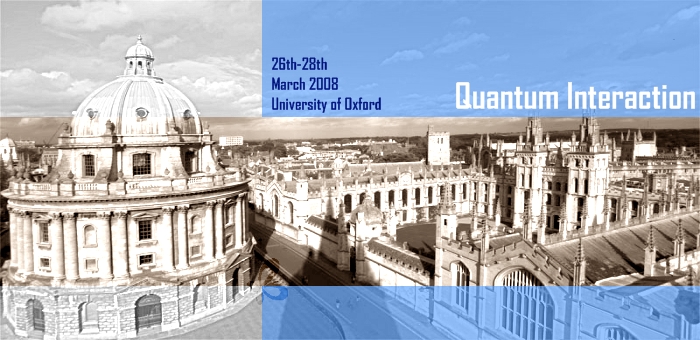 Respect our authority: Wikipedia
Respect our authority: Wikipedia
The quantum mind theory is founded on the premise that quantum theory is necessary to fully understand the mind and brain, particularly concerning an explanation of consciousness. This is considered a minority opinion in science.
(Of course, the bulk of academia is traditionally a generation behind the real innovators. Given the safety to be found in numbers, we momentarily lapse into the colloquial to advise the dedicated pedant and dutiful careerist to make (as it were) like a lemming.)
We are accustomed to regarding as real those sense perceptions which are common to different individuals, and which therefore are, in a measure, impersonal. The natural sciences, and in particular, the most fundamental of them, physics, deal with such sense perception. (Einstein)
Indoctrination
A key argument underlying the quantum mind thesis is that classical mechanics cannot fully explain consciousness. Proponents have suggested that quantum mechanical phenomena, such as quantum entanglement and superposition, may play an important part in the brain's function, and could form the basis of an explanation of consciousness.
(Quite a gasper, as the learned reader will readily acknowledge.)
There is nothing else except these [quantum] fields: the whole of the material universe is built of them. (Dyson)
The quantum mind thesis does not as yet have any evidence to confirm its validity, but some role of quantum processes in consciousness has not been completely ruled out.
(Of course, given that the brain just is a set of quanta, it would seem to follow that consciousness just might have something to do with those quanta, but for the moment a select committee of gibbering idiots would seem to serve as arbiters of majority opinion.)
Sufficient understanding of the operation of the brain could prove the proposition false.
(Ya think?)
Ongoing Debacle
The main argument against the quantum mind proposition is that the structures of the brain are much too large for quantum effects to be important.
(Gosh, aren't
black holes pretty darn big?)
The incorrect perception that the quantum system has only microscopic manifestations considerably confused this subject. As we have seen in preceding sections, manifestation of ordered states is of quantum origin. When we recall that almost all of the macroscopic ordered states are the result of quantum field theory, it seems natural to assume that macroscopic ordered states in biological systems are also created by a similar mechanism. (Umezawa)
It is impossible for coherent quantum states to form for very long in the brain and impossible for them to exist at scales on the order of the size of neurons.
Any physical system is completely described by a normalized vector (the state vector or wave function) in Hilbert space. All possible information about the system can be derived from this state vector by rules ... (Byron & Fuller)
(On the other hand, plant cells use quantum coherence and superposition on a daily basis, but our brain cells are clearly not quite so sophisticated as those found in your average eggplant.)
This does not imply that classical mechanics can explain consciousness, but that quantum effects including superposition and entanglement are insignificant.
To monochromatic light corresponds in the acoustic domain the simple tone. Out of different kinds of monochromatic light composite light may be mixed, just as tones combine to a composite sound. This takes place by superposing simple oscillations of different frequency with definite intensities. (Weyl)
When a state is formed by the superposition of two other states, it will have properties that are in some vague way intermediate between those of the original states and that approach more or less closely to those of either of them according to the greater or less 'weight' attached to this state in the superposition process.
The new state is completely defined by the two original states when their relative weights in the superposition process are known, together with a certain phase difference, the exact meaning of weights and phases being provided in the general case by the mathematical theory. (Dirac)
The second principle of color mixing of lights is this: any color at all can be made from three different colors, in our case, red, green, and blue lights. By suitably mixing the three together we can make anything at all, as we demonstrated ...
Further, these laws are very interesting mathematically. For those who are interested in the mathematics of the thing, it turns out as follows. Suppose that we take our three colors, which were red, green, and blue, but label them A, B, and C, and call them our primary colors. Then any color could be made by certain amounts of these three: say an amount a of color A, an amount b of color B, and an amount c of color C makes X:
X = aA + bB + cC.
Now suppose another color Y is made from the same three colors:
Then it turns out that the mixture of the two lights (it is one of the consequences of the laws that we have already mentioned) is obtained by taking the sum of the components of X and Y:
Z = X + Y = (a + a')A + (b + b')B + (c + c')C.
It is just like the mathematics of the addition of vectors, where (a, b, c ) are the components of one vector, and (a', b', c' ) are those of another vector, and the new light Z is then the "sum" of the vectors. This subject has always appealed to physicists and mathematicians. In fact: Schrödinger wrote a wonderful paper on color vision in which he developed this theory of vector analysis as applied to the mixing of colors. (Feynman)
 This looks vaguely familiar...
This looks vaguely familiar...
Thus the colors with their various qualities and intensities fulfill the axioms of vector geometry if addition is interpreted as mixing; consequently, projective geometry applies to the color qualities. (Weyl)
A speck in the visual field, though it need not be red must have some color; it is, so to speak, surrounded by color-space. Notes must have some pitch, objects of the sense of touch some degree of hardness, and so on. (Wittgenstein)
Probably just a coincidence...
Calabi-Yau space, from Elegant Universe
Quantum chemistry is required to understand the actions of neurotransmitters, for example.
(Now, as any half-learned buffoon can tell you, quantum chemistry reduces to quantum physics, but we seem to be in short supply of same and so it might seem as though we must make do with the distinguished assembly of slobbering imbeciles already cited. Happily, however, we have a deeply learned buffoon standing by in case of just such an emergency.)
In fact, biologists are trying to interpret as much as they can about life in terms of chemistry, and as I already explained, the theory behind chemistry is quantum electrodynamics. (Feynman)
However, this does not preclude the possible existence of mechanisms by which quantum effects could influence the state of larger structures.
(Since those larger structures also consist of quanta, this would seem a safe bet.)
... all chemical binding is electromagnetic in origin, and so are all phenomena of nerve impulses. (Salam)

Fractals are self-similar under changes of spatio-temporal scales.
Does neural form follow quantum function?
The text of this volume claims that the mathematical formulations that have been developed for quantum mechanics and quantum field theory can go a long way toward describing neural processes due to the functional organization of the cerebral cortex. (Pribram)
One well-known critic of the quantum mind is Max Tegmark. Based on his calculations, Tegmark concluded that quantum systems in the brain decohere quickly and cannot control brain function, "This conclusion disagrees with suggestions by Penrose and others that the brain acts as a quantum computer, and that quantum coherence is related to consciousness in a fundamental way."
(On the other hand,
Pauli believed that quantum mechanics would inform a
future theory of
mind & brain. Whom to believe -- Tegmark, or one of the founders of quantum theory? Hmm, that
is a puzzler. I wonder what would happen if we opened a book and looked up what those other guys thought?)
Bohr suggests that thought involves such small amounts of energy that quantum- theoretical limitations play an essential role in determining its character. (Bohm)
I believe that the first step in the setting of a "real external world" is the formation of the concept of bodily objects and of bodily objects of various kinds. Out of the multitude of our sense experiences we take, mentally and arbitrarily, certain repeatedly occurring complexes of sense impression (partly in conjunction with sense impressions which are interpreted as signs for sense experiences of others), and we attribute to them a meaning -- the meaning of the bodily object. Considered logically this concept is not identical with the totality of sense impressions referred to; but it is an arbitrary creation of the human (or animal) mind. On the other hand, the concept owes its meaning and its justification exclusively to the totality of the sense impressions which we associate with it. (Einstein)
The immediately experienced is subjective but absolute; no matter how cloudy it may be, in this cloudiness it is something given thus and not otherwise. To the contrary, the objective world which we continually take into account in our practical life and which science tries to crystallize into clarity is necessarily relative; to be represented by some definite thing (numbers or other symbols) only after a system of coordinates has been arbitrarily introduced into the world. We said at an earlier place, that every difference in experience must be founded on a difference of the objective conditions; we can now add: in such a difference of the objective conditions as is invariant with regard to coordinate transformations, a difference that cannot be made to vanish by a mere change of the coordinate system used ... (Weyl)
In attempting to judge the success of a physical theory, we may ask ourselves two questions: (1) “Is the theory correct?” and (2) “Is the description given by the theory complete?” It is only in the case in which positive answers may be given to both of these questions, that the concepts of the theory may be said to be satisfactory. The correctness of the theory is judged by the degree of agreement between the conclusions of the theory and human experience...
Whatever the meaning assigned to the term complete, the following requirement for a complete theory seems to be a necessary one: every element of the physical reality must have a counterpart in the physical theory. (EPR)
Anyone dissatisfied with these ideas may feel free to assume that there are additional parameters not yet introduced into the theory which determine the individual event. (Born)
If you ask a physicist what is his idea of yellow light, he will tell you that it is transversal electromagnetic waves of wavelength in the neighborhood of 590 millimicrons. If you ask him: But where does yellow comes in? he will say: In my picture not at all, but these kinds of vibrations, when they hit the retina of a healthy eye, give the person whose eye it is the sensation of yellow. (Schrödinger)
Thus, the task is, not so much to see what no one has yet seen; but to think what nobody has yet thought, about that which everybody sees. (Schrödinger)
Since matter clearly influences the content of our consciousness, it is natural to assume that the opposite influence also exists, thus demanding the modification of the presently accepted laws of nature which disregard this influence. (Wigner)
.



















